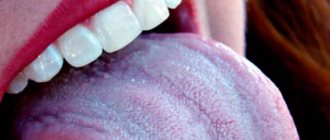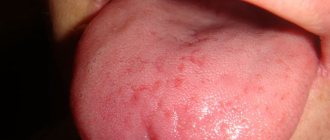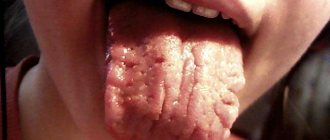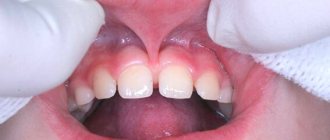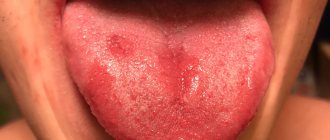A healthy human tongue should be pink, with a matte tint. A slight morning bloat, which decreases after eating, is also within normal limits. Alarm should be caused by the appearance of heavy plaque, usually resulting from an inflammatory process, or a change in the color of the back of the tongue. Sometimes you can see a blue tongue in a person, the reasons for this may be different. The most harmless of them are culinary or natural dyes; simply by eating some berries you may notice a change in the color of your tongue or lips. However, the cause is not always harmless; most often, a change in the appearance of the tongue is caused by various pathologies, including diseases of the stomach, pancreas, liver, etc.
Coated tongue
Everyone can check the state of the language and draw certain conclusions on their own. However, for this it is necessary to know exactly what indicators and factors tell us about certain changes in the state of the body.
Variations in the color of the tongue can be in a very wide range: whitish, brownish, blue, gray, yellowing may be observed. By the way, if a child suddenly has a strange tongue color, you should not immediately raise the alarm. In most of these situations, it turns out that the unusual coloring is caused by something quite ordinary that got into his mouth. These could be felt-tip pens, not very high-quality drinks, chewing gum, caramels . In adults, the cause may be recently drunk coffee or excessive smoking.
The next thing you need to pay attention to is the structure of the plaque on the tongue. Knowing what a healthy tongue looks like, you can easily notice the following differences from it:
- Dryness.
- Heterogeneity of plaque.
- Oiliness.
- Looseness.
- Density.
Be sure to set the thickness of the plaque, which is an extremely important parameter. If, during a visual examination, an increase in the degree of plaque formation is noticed, through which the surface of the tongue ceases to be visible, then control over the state of your body must be tightened. If the plaque condition does not improve within 24 hours, it is recommended to visit a doctor and undergo an examination.
Spots may appear on the surface of the tongue, the localization of which makes it possible to determine the location of the source of pathology in the body.
The degree of plaque pain is determined by the ease of its removal. In a healthy person, the layer of plaque is translucent, can be easily removed during morning hygiene, and does not appear during the day. If deposits appear as a result of a malfunction of any organ, then it is almost impossible to remove them completely; moreover, they gradually thicken, acquiring a color characteristic of the underlying pathology.
Normal plaque has a slightly whitish tint, which practically does not affect its transparency. It is easy to remove, has no odor, and the tissues of the tongue are visible through it. In cold weather, slight yellowing may appear.
Treatment
Treatment of macroglossia should be carried out taking into account the causes and factors that provoked the development of this disease. Specialists also take into account all changes (morphological or functional) that occurred during the course of the disease.
If an enlarged tongue is one of the manifestations of any disease, then paramount importance is given to the treatment of this “root cause” of the disease.
Drug treatment
If the disease occurs only locally (in the mouth), then drug treatment consists of local sanitation of the oral cavity and elimination of the cause of this disease.
If necessary, use general or local antibiotics, antiseptic and anti-inflammatory agents in the form of rinses or irrigations. Also, medications are necessarily used after surgery on the tongue to treat the wound and prevent secondary infection.
In addition, the drugs are also used for general diseases, when macroglossia is one of their symptoms. In this case, with the right treatment, the tongue shrinks on its own.
Surgical treatment
In severe cases of macroglossia, surgical treatment is more often used to correct the size of the tongue.
For such a radical method, there must be the following serious changes in the body:
- breathing problems;
- difficulty chewing and swallowing;
- serious aesthetic deviations in the facial area;
- open bite with the impossibility of using orthodontic treatment methods;
- constant drooling;
- speech therapy disorders (difficulty speaking and pronouncing sounds) that cannot be treated by a speech therapist.
During the operation, to normalize the size of the tongue, its wedge-shaped part is removed. In this case, the required part of the tongue is excised by a surgeon under general anesthesia, returning the organ to its normal size.
With an open bite, a prosthesis is usually installed to prevent the tongue from falling out of the mouth.
In cases of congenital form of the disease, children are often treated by ligation of the lingual arteries. This method slows down the growth of the tongue and allows you to restore optimal proportions.
In such cases, the prognosis for treating the disease is most often positive.
In case of tumor processes, treatment must be comprehensive, using surgical and chemotherapy methods, as well as drug and radiation therapy.
If you are diagnosed with macroglossia, you should not brush aside medical help and let everything take its course.
Indeed, in addition to constant discomfort in the mouth, people with a changed and enlarged tongue experience difficulties in communication, seriously worsening their own socialization. It is especially important to treat the disease as early as possible in children, preventing the occurrence of disorders in the dental apparatus and the formation of persistent psychological complexes in the child.
Sources used:
- Scully C, Porter S (July 2000). ABC of oral health. Swellings and red, white, and pigmented lesions"
- Perkins, J. A. (December 2009). "Overview of macroglossia and its treatment". Current Opinion in Otolaryngology & Head and Neck Surgery.
- "Therapeutic dentistry. Textbook" (Borovsky E. V.)
- “Diseases of the mucous membrane of the oral cavity and lips” (Bork K.)
Types of raids
The plaques that occasionally form on the surface of the tongue are very diverse. They differ in color, outline, and localization. Moreover, the color of the tongue and the disease are often directly related. In infectious pathologies, a dense whitish coating is usually observed that covers the entire surface. There is almost always a simultaneous increase in temperature.
If white deposits appear on the middle part of the tongue, and cracks form on the sides, then some pathological lesions of the stomach or intestines can be suspected. Having noticed the first manifestations, it is recommended to change the diet to a more easily digestible one, limiting salt and fat. The appearance of pain indicates the need for emergency examination by a doctor.
White deposits that appear on the front of the organ are evidence of problems with the respiratory system, with the most common cause being tobacco smoking. At the same time, sometimes a person’s speech changes tonality. Developing dysbacteriosis often leads to a fungal infection, manifested in particular by the appearance of whitish spots on the entire surface. Quite often it develops as a result of improper treatment with antibiotics.
An alarming signal is the appearance of a red and white spotted coating. This is what the symptoms of scarlet fever look like. Having noticed such formations, you should immediately seek medical advice; a timely and effective treatment method will allow you to quickly get rid of the pathology without any consequences.
If your tongue turns yellow, you should pay attention to the amount of deposits. A small amount of yellowish plaque should usually not cause concern. However, the intensive formation of a thick layer allows one to suspect the presence of foci of inflammation inside the gallbladder. In this case, you should pay attention to the presence of unpleasant sensations under the ribs on the right side. These are the signs of developing cholecystitis.
A burgundy coating over time turning into a brown crust often indicates food poisoning. If it is small and passes quickly enough, then coloring can occur due to the use of food (natural) dyes, for example, chocolate or coffee. The prolonged presence of such deposits usually indicates dysbacteriosis.
Symptoms
Macroglossia can be true or false. Sometimes abnormal development of the jaw arch is mistaken for an increase in lingual tissue. In case of recession or congenital narrowness of the jaw, this ailment is considered false. With true macroglossia, the tongue is enlarged by one and a half to two times. However, this form of the disease occurs rarely.
Macroglossia in newborns
It is important to identify this disease in a timely manner, as this will greatly affect the success of its treatment and the likelihood of it becoming chronic.
Therefore, it is especially important to identify such pathology during the neonatal period.
When examining a newborn, it is important not to miss such manifestations of the disease as:
- enlargement of the tongue when it protrudes beyond the mouth;
- “varnished” or dried surface;
- tuberosity, enlarged papillae;
- blocking of the larynx by the root of the tongue, which forces the baby to refuse food;
- slightly open mouth;
- labored breathing;
- excessive salivation;
- frequent attacks of asphyxia (breathing problems);
- frequent infection and increased body temperature;
- deterioration of general condition.
Very often, children in the first year of life experience a local form of the disease. Often tongue pathology occurs in the fetus for the following reasons:
- improper development;
- idiopathic diseases with symptoms of hypertrophy of the lingual muscles;
- the formation of cysts or cavities during the formation of the tongue muscles;
- with adverse factors affecting the pregnant woman’s body (intoxication, radiation, infections).
Blue tongue
Some people notice that their tongue has a blue tint. Naturally, this attracts attention and an explanation needs to be found as to why this happens. A blue tongue in a person, if it is not colored by berry juice or other dyes, is a fairly important signal of serious health problems.
Why can the tongue turn blue? This coloration may appear as a result of any serious problem in the functioning of the cardiac system. This most often occurs in heart failure. Cardiopulmonary failure with circulatory problems is especially clearly indicated by the localization of cyanosis on the lower parts of the tongue. In this situation, it is advisable to analyze the general condition, summarize all unpleasant sensations and contact a medical specialist for examination.
If cyanosis appears on the upper plane, then this is almost accurate evidence of the onset of progression of cardiovascular failure, while the remaining symptoms (pain, weakness, feeling of heaviness behind the sternum) may not yet appear. Timely response and implementation of a set of medical measures can often prevent a heart attack.
The tongue may also have a bluish tint. In addition to some disruption of blood circulation, this may reflect the development of the initial stages of scurvy. If a blue plaque suddenly appears in the area located directly in front of the pharynx, then the cause must be sought in a violation of renal activity. Normalization of the functioning of the adrenal glands (proper production of hormones) usually leads to the disappearance of such spots.
Quite rare, but sometimes occurs, a bluish tint appears due to poisoning with heavy metals, for example, mercury. Only a specialist can identify such a lesion after conducting a serious examination.
Manifestations of chronic macroglossia
Often, tongue enlargement that is not cured in time leads to a severe chronic course of the disease. In this case, in an adult, the following manifestations of this pathology can be identified:
- the volume of the tongue is significantly increased, its movements are limited;
- the mouth is constantly slightly open;
- the lingual surface is rough, often with cracks or blue bloody blisters, with increased bleeding;
- copious amounts of saliva;
- permanent injury to the tongue tissue from dental crowns;
- speech is slurred, unclear, pronouncing words with difficulty.
Blue plaque in a child
Every young mother needs to make a daily morning examination of her child’s mouth a mandatory procedure. It should be borne in mind that a small whitish layer, which is easily removed by hygiene procedures or disappears on its own after eating, is the norm. But the appearance of a thick layer or a change in color should cause serious concern.
It is especially necessary to react quickly to a child’s blue tongue. Why should the blue tint of the tongue attract such increased attention? This shade serves as one of the main signals that can reflect the occurrence of a number of pathological problems that begin to progress in the important organs of the child. With such a change in color, problems with the respiratory system, heart (arrhythmias, angina pectoris, etc.), circulatory system, and kidneys can be suspected.
In such a situation, parents are advised to immediately consult a doctor. Young children are not always able to fully describe the sensations that arise, and young parents are not always able to correctly identify what the child is describing. That is why such an important signal should encourage parents to visit a medical facility. Another reason for a blue tongue in a small child may be disorders of the nervous system. With such problems, seizures or cerebrovascular accidents are usually observed simultaneously.
Consequences of macroglossia
Sometimes patients do not perceive macroglossia as a serious pathology and do not contact specialists in a timely manner. However, such a defect in the body as a large tongue can cause a person a lot of inconvenience and serious complications. First of all, the condition of the patient’s dentition is seriously disturbed. The tongue itself suffers from excessive dryness and is often injured and inflamed.
Also, an enlarged tongue interferes with the normal socialization of children, being a cosmetic defect. Most patients acquire psychological complexes.
After all, not all of their peers are ready to be friends with children whose tongues stick out, their speech is slurred, and there is also a constant flow of saliva from their mouths.
However, this is not all. With a long course, the disease often leads to the following pathologies of the body:
- breathing problems and the habit of breathing through the mouth;
- problems with diction (especially pronouncing hissing sounds);
- violation of the formation of the dentofacial apparatus with pathologies of the formation of dentition;
- digestive problems (the appearance of ulcers, colitis and gastritis) due to difficulties in chewing food.
In addition, an untreated disease causes pain and constant discomfort in the mouth. The tongue is inflamed, enlarged, stiff, and even subject to constant biting.
Non-dangerous causes of appearance
The causes of red dots on the tongue that are not dangerous are:
- Eating foods colored red.
- Eating very hot or spicy food.
- Irritation or injury from wearing dentures.
- Changes in bite after visiting the dentist.
- Tongue burn.
- Allergic reaction to toothpaste and other oral hygiene products, food products.
- Smoking.
If none of the above explanations are found in a person, it is necessary to look for reasons of a more serious nature. The most common ones should be considered.
Reason in Chinese traditional medicine
According to Chinese medicine experts, the presence of a purple tongue may indicate either excessive heat and decreased fluid (i.e., internal dryness) in the body (due to increased heat production), or a so-called cold condition, which causes “stagnation of blood.” poor circulation, elevated sugar levels, leaving you feeling tired and cold inside.”[dailymail.co.uk]. A likely cause of this problem may be the consumption of cooling (mainly Yin) foods. You should make sure you have warming (yang) ingredients in your diet, such as ginger, coriander, cinnamon and horseradish.
Chinese Medicine Basics Regarding Purple Tongue:
- If you have a greenish or bluish-purple or light purple tongue, there is probably stagnation of blood in the body and internal cold prevails in the body.
- A dark reddish-purple color indicates that your body is losing fluid (internal dryness) due to excessive heat, and your body is stagnating due to internal heat.
- A light purple hue indicates that you probably have a dominant internal wind.
There are many other diseases and syndromes that can cause a purple tongue. It is important to consult a qualified doctor in time, who will not only make the correct diagnosis, but also prescribe adequate treatment.
Diseases that provoke Gunter-Miller glossitis
A smooth tongue is just an external manifestation of internal diseases, many of which are associated with an acute lack of one or another vitamin in the body. Let us list the main causes of pathology:
- Pernicious anemia: This is a malignant anemia associated with a deficiency of vitamin B12 as well as folic acid. Long-term use of medications, intestinal disorders, oncology in the gastrointestinal tract, autoimmune abnormalities, and congenital metabolic disorders can affect the absorption of these substances beneficial to the body. Moderate deficiency of these vitamins is often observed in vegetarians, malnutrition and alcoholism,
- pellagra: this is a disease that occurs due to a lack of nicotinic acid (vitamin B 3 or PP). At particular risk are people who abuse alcohol and cigarettes, as well as those who live in difficult living conditions and eat very little. The development of pellagra is promoted by acute and chronic gastrointestinal diseases, ultraviolet radiation, long-term use of antibiotics and antidepressants,
- sprue: a rare infectious disease characterized by a disorder of the gastrointestinal tract. It is found in people who have visited endemically unfavorable areas of the Earth (the Caribbean, India, Asia).
Chinese health diagnostics by language: Five Elements
Eastern medicine considers this organ as a point of passage for a number of important energy channels. The corresponding meridian shows the state of the organ that is connected to it. According to the principles of the Five Elements theory, there is the following relationship between language areas and internal systems:
- The tip is connected to the heart and lungs.
- The lateral sections indicate the condition of the liver and gall bladder.
- The dorsum is connected to the spleen and the gastrointestinal tract.
- The condition of the root indicates the level of kidney health.
In the event of problems affecting internal organs, the tongue reacts first to the change. Based on the condition of this part of the body, a competent diagnostician can not only determine what kind of disease is being discussed in a particular case, but also determine whether it is chronic or not and at what stage it is.
Tongue peels during pregnancy
You're pregnant and your tongue is peeling. What could be the problem? Below is how you can solve this problem.
While pregnant, some women sometimes develop a “blue tongue.” This staining may intensify after a while, and the tongue begins to peel off. This condition can develop due to nutritional deficiencies. In this case, it is necessary to urgently undergo a dental examination. Also, the problem of “blue tongue” can be associated with bloating, sleep disturbances, probably due to anxiety and certain eating habits.
Additionally, tongue peeling during pregnancy can sometimes occur due to an imbalance in thyroid hormone levels. If this is the case, then you need to seek help from an endocrinologist.
It is also important to note that some of the reasons that have already been discussed above can lead to peeling of the tongue mucosa during pregnancy.
